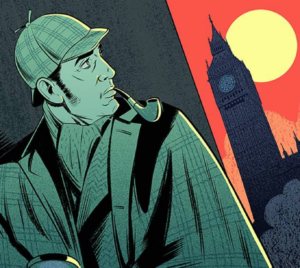
Illustration by Dominic Bugatto
From Oedipus to Sherlock Holmes, readers have flocked to stories about determined detectives.
May 21, 2020
I have to confess that I’ve spent the lockdown reading thrillers and whodunits. But judging by the domination of mystery titles on the bestseller lists, so has nearly everyone else. In uncertain times, crime fiction offers certainty, resolution and comfort.
The roots of the genre go back to the ancient Greeks. Sophocles’s “Oedipus the King,” written around 429 B.C., is in essence a murder mystery. The play begins with Oedipus swearing that he will not rest until he discovers who killed Laius, the previous king of Thebes. Like a modern detective, Oedipus questions witnesses and follows clues until the terrible truth is revealed: He is both the investigator and the criminal, having unwittingly murdered his father and married his mother.
The Chinese were the first to give crime fiction a name. Gong’an or “magistrate’s desk” literature developed during the Song dynasty (960-1279), featuring judges who recount the details of a difficult or dangerous case. Modern Western crime fiction adopted a more individualistic approach, making heroes out of amateurs. The 1819 novella “Mademoiselle de Scuderi,” by the German writer E.T.A. Hoffmann, is an early prototype: The heroine, an elderly writer, helps to solve a serial murder case involving stolen jewelry.
But it is Edgar Allan Poe who is generally regarded as the godfather of detective fiction. His short story “The Murders in the Rue Morgue,” published in 1841, features an amateur sleuth, Auguste Dupin, who solves the mysterious, gruesome deaths of two women. (Spoiler: The culprit was an escaped orangutan.) Poe invented some of the genre’s most important devices, including the “locked room” puzzle, in which a murder takes place under seemingly impossible conditions.
Toward the end of the 19th century, Arthur Conan Doyle’s Sherlock Holmes series added three innovations that quickly became conventions: the loyal sidekick, the arch-villain and the use of forensic science. In the violin-playing, drug-abusing Holmes, Doyle also created a psychologically complex character who enthralled readers—too much for Doyle’s liking. Desperate to be considered a literary writer, he killed off Holmes in 1893, only to be forced by public demand to resurrect him 12 years later.
When Doyle published his last Holmes story in 1927, the “Golden Age” of British crime fiction was in full swing. Writers such as Agatha Christie and Dorothy L. Sayers created genteel detectives who solved “cozy crimes” in upper-middle-class settings, winning a huge readership and inspiring American imitators like S.S. Van Dine, the creator of detective Philo Vance, who published a list of “Twenty Rules for Writing Detective Stories.”
As violence and corruption increased under Prohibition, American mystery writing turned toward more “hard-boiled” social realism. In Dashiell Hammett and Raymond Chandler’s noir fiction, dead bodies in libraries are replaced by bloody corpses in cars.
At the time, critics quarreled about which type of mystery was superior, though both can seem old-fashioned compared with today’s spy novels and psychological thrillers. The number of mystery subgenres seems to be infinite. Yet one thing will never change: our yearning for a hero who is, in Raymond Chandler’s words, “the best man in his world and a good enough man for any world.”






